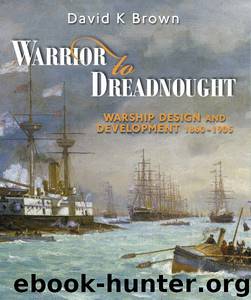Warrior to Dreadnought: Warship Design and Development 1860-1905 by David K Brown

Author:David K Brown [Brown, David K]
Language: eng
Format: epub, azw3
Tags: HISTORY / Military / Naval
ISBN: 9781783830190
Publisher: Naval Institute Press
Published: 2010-09-21T21:00:00+00:00
Phaeton of the Leander class, 1883, developed from Mercury. (Author’s collection)
One such comparison was for a Boadicia in early 1877 for which details of a belted and deck protected ship are given below.
Both were rejected by the Board who wanted a smaller and cheaper ship and though this was ordered as Highflyer in August, it was cancelled soon after.24
Leander and Mersey (ld 1880–82)
The Leanders were designed in 1880 after some dispute between Board members; Cooper Key wanted an enlarged, 15kt Comus whilst others wanted an improved Mercury; backed by the First Lord, Smith, the latter was chosen but, in order to fit a 1½in protective deck over 165ft amidships, she lost 0.5-lkt in speed and was a bit larger. The much better 6in BL was available and she carried ten of them, five on each beam with the forward and after guns each side on centre pivot mountings. She also mounted a heavy armament of machineguns, sixteen in all (two Gatling, four Gardner, ten Nordenfelt). The protective deck differed from that in Comus by having the deck at centre just above the normal waterline and the sides sloped down to protect against shells entering at the waterline. Her compound engines were a little more efficient and with increased coal supply she had an endurance of 8000 miles at 10kts. She had a light barque rig, similar to Mercury, and enough freeboard to make her a good seaboat.
Leander and her three sisters were very successful and may be seen as the ancestors of most cruisers for the rest of the century and beyond. Their general configuration was scaled up to the big First Class cruisers and down to the torpedo cruisers, whilst traces of the protected deck scheme can even be recognised in some sloops. The 1888 manoeuvres report criticised Arethusa for heavy rolling and recommended reducing top weight by doing away with her square rig.
The next step was the Mersey class of three ships whose main features were agreed only after prolonged debate. Cooper Key wanted a torpedo cruiser and in April/May 1882 the DNC prepared a design based on Leander of 2800 tons with a 2in deck, four 6in guns and ten submerged torpedo tubes. White, the head of section, was concerned that submerged tubes had not been tried25 and would not be until Polyphemus ran trials later that year. Alternative designs carried two 9.2in and six 6in or fourteen 6in. The torpedo carrier was quietly dropped (see later) but when the first two ships were ordered in the spring of 1883 there were still great differences in armament under consideration. All variants had a pair of larger guns (9.2in, 8in or a new 7in) with a number of 6in; eventually, they completed with two 8in and ten 6in, costing £210,000.26 The armour deck was increased to 2in on the flat and 3in on the slopes and ran from end to end, curving down at the bow to support the ram. The 1888 report saw them as very good ships but recommended replacing the 8in by 6in to reduce top weight.
Download
Warrior to Dreadnought: Warship Design and Development 1860-1905 by David K Brown.azw3
This site does not store any files on its server. We only index and link to content provided by other sites. Please contact the content providers to delete copyright contents if any and email us, we'll remove relevant links or contents immediately.
| Africa | Americas |
| Arctic & Antarctica | Asia |
| Australia & Oceania | Europe |
| Middle East | Russia |
| United States | World |
| Ancient Civilizations | Military |
| Historical Study & Educational Resources |
The Radium Girls by Kate Moore(11899)
100 Deadly Skills by Clint Emerson(4824)
Rise and Kill First by Ronen Bergman(4682)
The Templars by Dan Jones(4614)
The Doomsday Machine by Daniel Ellsberg(4397)
The Rape of Nanking by Iris Chang(4124)
Killing England by Bill O'Reilly(3937)
Hitler in Los Angeles by Steven J. Ross(3891)
Stalin by Stephen Kotkin(3865)
12 Strong by Doug Stanton(3495)
Hitler's Monsters by Eric Kurlander(3256)
Blood and Sand by Alex Von Tunzelmann(3119)
Darkest Hour by Anthony McCarten(3058)
The Code Book by Simon Singh(3055)
The Art of War Visualized by Jessica Hagy(2932)
Hitler's Flying Saucers: A Guide to German Flying Discs of the Second World War by Stevens Henry(2699)
Babylon's Ark by Lawrence Anthony(2562)
The Second World Wars by Victor Davis Hanson(2467)
Tobruk by Peter Fitzsimons(2432)
